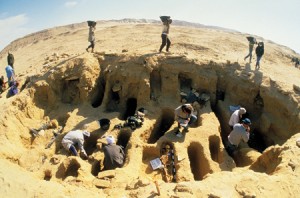Ancient Egyptian Cemetery with One Million mummified bodies found
American archaeologists are excavating a graveyard in Egypt that could enclose over a million mummified bodies.
The leftovers of more than 1,700 people have already been unearthed in the graveyard, which is known as Fag el-Gamous and is located about 96 kilometers south of Cairo in the Faiyum region. Judging by the density of the burials and the large size of the cemetery, the archaeologists consider that it could have over a million bodies.
The mummies appear to be those of common people, rather than dignitaries, who were buried around 1,500 years ago, when Egypt was controlled by the Roman and Byzantine empires. The people covered in the cemetery had few goods covered with them and were laid in the ground without coffins.
The bodies, which were physically mummified by the hot and dry desert conditions, were buried in deep shafts cut into the limestone rock. The depth of some of the shafts exceeds 30 meters.
The archeologists, who come from Brigham Young University in Provo, Utah, are mystified by the origin of all the bodies. A village that has been exposed nearby would have been too small to warrant such a large cemetery and the nearest town, named Philadelphia after King Ptolemy II Phiadelphus, has its own burial sites.
Bizarrely, the mummies emerge to be clustered together by hair color, with those with blond hair in one area and those with red hair in another.
Among the recent discoveries made last year were the mummified leftovers of a little girl aged around 18 months old, still with two jewels on each arm, and a woman with long blonde hair.
Quite a few of our mummies had excellent teeth, something that is unusual,” said project director Professor Kerry Muhlestein.
The excavation site is also home to the small Seila pyramid, which researchers consider may be the second or third true pyramid ever constructed.
Muhlestein said it was constructed by Snerfu, the former king of the fourth dynasty who discovered how to build a true pyramid after his predecessors built step pyramids for generations.
Though the cemetery was first exposed some 30 years ago, excavation has been speeded-up due to encroachment by local farmers expanding their cultivable area.
The BYU team is now creating a database with information about burials, burial goods and textiles like mummy wrappings. Researchers hope to conduct a demographic study to learn more about the lifetime of people in the area, including infant and child mortality rates.
Muhlestein said it can be hard to learn about the common man because they aren’t very visible in written sources, but findings from the cemetery can provide insight into what life was like.
